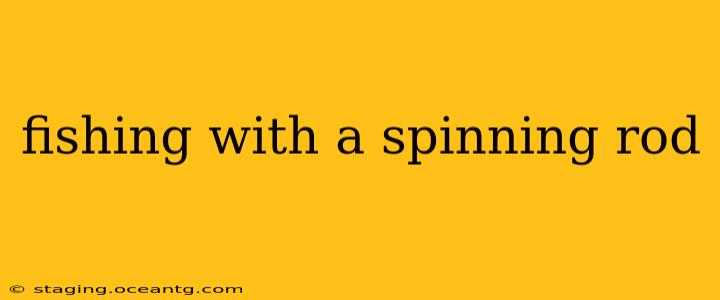Spinning rods are incredibly versatile, making them a popular choice for anglers of all skill levels. Whether you're targeting bass in a lake, trout in a river, or even saltwater species, understanding the techniques involved in spinning rod fishing can significantly improve your success. This comprehensive guide will cover everything you need to know, from choosing the right gear to mastering various casting techniques.
What is a Spinning Rod and Reel?
A spinning rod and reel setup is characterized by its open-faced reel that sits below the rod. The line is fed from a spool on the reel, and the spinning action allows for smooth casting and retrieval. Unlike baitcasting reels, spinning reels are generally easier to learn, making them ideal for beginners. The rod itself is usually lightweight and flexible, designed to handle a variety of lures and techniques.
What are the benefits of using a spinning rod?
Spinning rods offer several key advantages that contribute to their popularity:
- Versatility: Spinning gear can be used for a wide range of fishing applications, from targeting small panfish to larger game fish.
- Ease of Use: They are generally easier to learn than baitcasting setups, making them a great choice for beginners.
- Sensitivity: The lighter action of many spinning rods provides excellent sensitivity, allowing you to feel subtle bites and react quickly.
- Precise Casting: Spinning reels allow for precise casting, particularly important when targeting fish in tight spaces.
What types of lures are best for spinning rods?
The type of lure you choose will depend largely on the species you're targeting and the conditions you're fishing in. However, spinning rods are well-suited for a variety of lures, including:
- Spinnerbaits: Excellent for covering water and attracting aggressive fish.
- Spoons: Versatile lures that can be retrieved at various speeds and depths.
- Crankbaits: Ideal for targeting fish near structure or cover.
- Soft Plastics (Worms, Tubes, etc.): Highly effective for enticing a wide range of species.
- Jigs: Versatile lures that can be fished in many different ways.
How do I choose the right spinning rod and reel?
Selecting the appropriate spinning rod and reel combination is crucial for success. Consider these factors:
- Rod Length: Rod length influences casting distance and power. Shorter rods (under 6 feet) are great for finesse fishing, while longer rods (over 7 feet) offer more casting distance.
- Rod Power: Rod power refers to its ability to handle different weights of lures and fish. Light to medium power rods are suitable for smaller fish and lighter lures, while medium-heavy to heavy power rods are better suited for larger fish and heavier lures.
- Reel Size: Reel size is usually denoted by a number (e.g., 2000, 3000, 4000). Larger numbers indicate larger reels with greater line capacity.
- Line Type and Weight: The type and weight of your fishing line should be matched to your rod and reel, as well as the lures you'll be using.
How to Cast with a Spinning Rod: A Step-by-Step Guide
Casting accurately and efficiently is crucial for spinning rod fishing. Here's a breakdown of the process:
- Proper Grip: Hold the rod firmly but not too tightly, using your index finger to control the spool.
- Line Management: Make sure your line isn't tangled or twisted before casting.
- The Cast: Make a smooth, pendulum-like motion with your rod, releasing the line at the end of your swing.
- Practice: Consistent practice is key to mastering your casting technique.
What are some common mistakes to avoid when using a spinning rod?
- Using the wrong line weight: Too light of a line will break easily, while too heavy a line will hinder sensitivity.
- Over-casting: Casting too hard can lead to tangles and inaccurate casts.
- Not adjusting your drag: Proper drag adjustment is crucial to prevent line breakage when fighting a fish.
- Ignoring proper rod maintenance: Regular cleaning and maintenance will extend the life of your equipment.
What are some tips for beginners using spinning rods?
- Start with lighter lures and practice your casting technique in an open area.
- Use a braided line for increased sensitivity and durability.
- Experiment with different retrieves to find what works best for the conditions.
- Consider taking a fishing class or seeking guidance from an experienced angler.
Conclusion
Mastering the art of fishing with a spinning rod is a rewarding experience. By understanding the different components, techniques, and potential challenges, you can significantly improve your angling skills and enjoy many successful fishing trips. Remember that consistent practice and a willingness to learn are key to becoming a proficient spinning rod angler.
